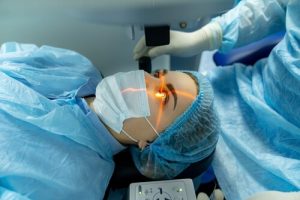Can laser eye surgery fix astigmatism? This question lingers in the minds of many who struggle with this vision irregularity. Astigmatism, characterized by an imperfectly shaped cornea, can blur near and distant vision, impacting daily activities. In this article, we’ll delve into the capabilities of laser eye surgery to address astigmatism, exploring advanced procedures and their potential for restoring clear vision. Join us as we uncover whether this innovative technology can be the solution to achieving crisp, focused sight. If you’re considering treatment options, visiting a trusted eye clinic Melbourne could be your first step toward clearer vision.
Introduction to Astigmatism and Laser Eye Surgery
Astigmatism, a common refractive error characterized by an irregular curvature of the cornea or lens, leads to many vision problems and distorted or blurred vision. This condition affects how light is focused onto the retina, often resulting in a blurred or distorted image—many question whether laser eye surgery can effectively correct this issue. Laser eye surgery, including procedures like LASIK and PRK, has advanced significantly, offering new hope for those struggling with astigmatism.
Nature of Astigmatism:
Unlike normal eye conditions where the cornea has a symmetrical round shape (like a soccer ball), astigmatism involves a dual curvature akin to a rugby ball. This irregularity causes light to focus on multiple points within the eye at one point, leading to blurry or distorted vision.
Laser Eye Surgery for Astigmatism:
Laser vision correction procedures, specifically LASIK (Laser-Assisted In Situ Keratomileusis) and PRK (Photorefractive Keratectomy) are designed to reshape the cornea using a highly precise excimer laser. This reshaping helps correct the uneven curvature and brings images into clearer focus from blurry vision.
Procedure Details:
LASIK involves creating a thin corneal flap to access the underlying corneal tissue, while PRK removes the cornea’s outer layer entirely, regenerating over time. Depending on the specific type of astigmatism, both procedures aim to flatten the steep curve of the cornea or make it more symmetrical.
Effectiveness and Suitability:
Laser eye surgery has proven effective in treating astigmatism and other refractive errors, such as myopia (nearsightedness) and hyperopia (farsightedness). However, a patient’s suitability for laser surgery depends on several factors, including corneal thickness, overall eye health, the eye doctor, and the degree of refractive error.
How Laser Eye Surgery Corrects Astigmatism
Laser eye surgery represents a transformative solution for those struggling with astigmatism, a common refractive error that distorts vision due to an irregularly shaped cornea or lens. These surgical procedures can effectively reshape the cornea corrective lenses by utilizing precise laser techniques, correcting how light is focused onto the retina, and significantly improving visual clarity.
Understanding the Correction Process: Laser eye surgery corrects astigmatism by reshaping the cornea’s uneven curvature, which is responsible for distorted vision. This is achieved by precisely removing corneal tissue, enhancing the eye’s ability to focus light directly onto the retina.
Types of Procedures: The most common types of laser eye surgery for astigmatism include LASIK and PRK. LASIK is laser eye surgery that corrects astigmatism by forming a thin flap in the cornea, lifting it, and then utilizing an excimer laser to reshape the underlying corneal tissue. PRK, on the other hand, does not involve flap creation; instead, it entails removing the cornea’s outer layer entirely before reshaping it with the laser.
Precision Tools: Advanced lasers, such as the excimer laser, perform minute and accurate adjustments to the corneal shape. This laser precisely ablates the tissue with minimal impact on the surrounding areas of dry eyes, which is crucial for effectively treating astigmatism.
Customization of Treatment: Each laser eye surgery is tailored to the individual’s specific vision needs. Diagnostic tools accurately measure the eye’s surface, creating a detailed cornea map. This map guides the laser eye surgeon in customizing the treatment according to each patient’s eyes’ unique curvature and specific requirements.
Different Types of Laser Procedures for Astigmatism



When correcting astigmatism with laser eye surgery, several specialized procedures are designed to reshape the cornea and improve vision. Here are the primary types of laser surgeries used to treat astigmatism:
LASIK (Laser-Assisted In Situ Keratomileusis)
- Procedure: LASIK is the most well-known and commonly performed type of laser eye surgery for astigmatism. It entails forming a slender flap in the cornea using either a microkeratome blade or a femtosecond laser. The flap is lifted, and an excimer laser reshapes the underlying corneal tissue by smoothing irregularities to correct the refractive error.
- Recovery: LASIK typically offers a quick recovery time. Many patients experience significant improvements in vision almost immediately after surgery, and most return to normal activities within a day or two.
PRK (Photorefractive Keratectomy)
- Procedure: PRK is similar to LASIK but does not involve creating a corneal flap. Instead, the outer layer of the cornea is completely removed before reshaping the underlying area with an excimer laser. This is particularly suitable for patients with thinner corneas.
- Recovery: Recovery from PRK is usually longer than with LASIK because the epithelium needs time to heal and regenerate, which can take several days to a few weeks. Patients often experience more discomfort during the initial healing period.
LASEK (Laser Assisted Sub-Epithelial Keratectomy)
- Procedure: LASEK combines elements of both LASIK and PRK. The procedure involves creating an ultra-thin flap in the epithelial layer, which is then treated with alcohol to loosen, allowing the surgeon to lift it and apply the laser to reshape the cornea.
- Recovery: Recovery from LASEK is typically quicker than PRK but slightly longer than LASIK and less uncomfortable than PRK.
SMILE (Small Incision Lenticule Extraction)
- Procedure: SMILE is a newer technique that uses a femtosecond laser to make a small, lens-shaped bit of tissue within the cornea, which is then removed through a small incision. This minimally invasive procedure does not need to form a flap, making it a good option for patients concerned about flap complications.
- Recovery: Recovery from SMILE is quick, with most patients reporting minimal discomfort and rapid visual recovery, similar to LASIK.
Evaluating Candidacy for Laser Eye Surgery with Astigmatism



Evaluating candidacy for laser eye surgery when dealing with astigmatism involves a detailed assessment of various factors to decide if a patient is suitable for the surgical procedure. Here’s how the evaluation process typically unfolds:
Comprehensive Eye Examination
- Initial Assessment: A thorough eye exam is essential. The eye surgeon checks for the degree and type of astigmatism and other potential eye issues, such as cataracts or glaucoma.
- Corneal Topography: This diagnostic tool creates a detailed map of the cornea’s curvature, essential for planning the surgery and assessing whether it can be safely and effectively reshaped.
Corneal Thickness
Measurement: The thickness of the cornea is measured to ensure it is sufficient to withstand tissue removal during the reshaping process. Insufficient corneal thickness can lead to complications post-surgery.
Age and Stability of Vision
- Age Requirements: Patients typically need to be at least 18, as younger individuals may still have changing vision.
- Vision Stability: It’s important that the patient’s prescription has not changed significantly for at least a year, indicating stable vision, which is crucial for a successful outcome.
Overall Eye Health
- Health Status: Good overall eye health is required, with no active diseases such as uncontrolled glaucoma or severe dry eye syndrome, which could complicate the surgery or recovery.
- Medical Conditions: Conditions like diabetes or autoimmune diseases affecting healing should be well-managed, or surgery may not be advised.
Patient Expectations
- Realistic Expectations: The surgeon will discuss what the surgery can and cannot achieve. It is crucial to understand and have realistic expectations about the outcomes and potential side effects or complications.
- Lifestyle Considerations: Certain lifestyles or professions may influence the decision for surgery, particularly if they involve activities that pose risks to the eyes.
Other Refractive Errors
Combined Conditions: Patients often have astigmatism combined with myopia (nearsightedness) or hyperopia (farsightedness). The surgeon will evaluate the extent to which these conditions can also be corrected during the procedure.
Potential Risks and Complications of Laser Surgery for Astigmatism



Laser surgery for astigmatism, while highly effective and transformative for many, also carries potential risks and complications. Patients need to be fully aware of these before undergoing the procedure. Here are some of the most common risks associated with laser eye surgery for astigmatism:
Under correction or Overcorrection:
If the laser removes too little or too much tissue from the eye, it may not correct astigmatism to the desired extent. Undercorrection or overcorrection can lead to continued reliance on glasses or contact lenses or the need for additional surgical procedures.
Visual Disturbances:
- Glare and Halos: Some patients experience increased glare and halos around lights, particularly at night, which can impair driving and seeing in low-light conditions.
- Double Vision: Temporary double vision can occur as the eye heals and adjusts to its new shape.
Dry Eye Syndrome:
- Symptoms: Laser surgery can decrease tear production, leading to dry eye symptoms. This condition can be uncomfortable and may affect vision clarity.
- Management: Dry eye symptoms are typically managed with lubricating eye drops and sometimes require long-term treatment.
Flap Complications (specific to LASIK):
- Issues: In LASIK, complications can arise from the corneal flap made during surgery. These might include improper flap healing, folds in the flap, or particles getting trapped under the flap, all of which can affect vision.
- Correction: Flap complications may require additional surgical interventions to correct or manage.
Infection and Inflammation:
- Risk: Though rare, infection and inflammation post-surgery are possible and can lead to pain, reduced vision, and other serious complications.
- Prevention: Strict adherence to post-operative care guidelines and using prescribed medications can help minimize these risks.
Regression:
- Definition: Regression is when the eye slowly returns to its original prescription. This is more common in patients with high prescriptions and can necessitate further treatment.
- Management: Some regression cases may require additional enhancement surgeries or be managed with glasses for certain activities.
Loss of Vision:
- Severity: Although very rare, there is a small risk of significant vision loss from laser eye surgery. This could be due to severe complications like infection, profound scarring, or other unpredictable responses to the surgery.
In conclusion, whether laser eye surgery can fix astigmatism is met with promising answers. Modern advancements in laser technology offer effective solutions for correcting astigmatism, allowing many to enjoy clearer vision without needing to wear glasses, or contacts. By consulting with a qualified eye doctor at Dr Ed Ophthalmologist Melbourne clinic, you can determine if this treatment suits you and take a step towards sharper, more reliable vision.
References
Laser eye surgery and lens surgery – NHS
https://www.nhs.uk/conditions/laser-eye-surgery-and-lens-surgery/
LASIK surgery: Is it right for you? – Mayo Clinic
https://www.mayoclinic.org/tests-procedures/lasik-eye-surgery/in-depth/lasik-surgery/art-20045751
Lasik for Astigmatism: What to Expect
https://www.healthline.com/health/eye-health/lasik-for-astigmatism
Can LASIK Fix Astigmatism? – Refractive Surgery Council
https://americanrefractivesurgerycouncil.org/can-lasik-fix-astigmatism/
Eyes – laser eye surgery – Better Health Channel
https://www.betterhealth.vic.gov.au/health/conditionsandtreatments/eyes-laser-eye-surgery

